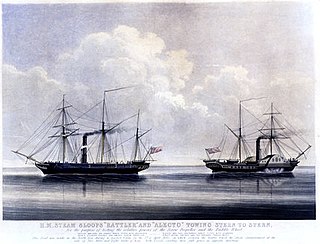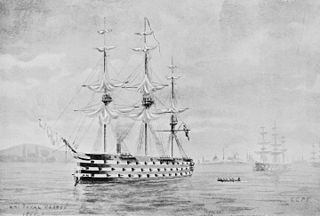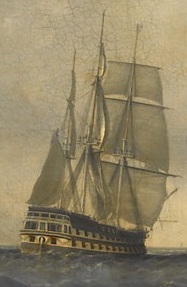
HMS La Hogue was a 74-gun third-rate ship of the line of the Royal Navy, launched on 3 October 1811 at Deptford. She was named after the 1692 Battle of La Hogue. "The La Hogue of 1811 [...] sported a green and chocolate lion, its grinning mouth displaying rows of white teeth and a huge red tongue."

HMS Britannia was a 120-gun first-rate ship-of-the-line of the Royal Navy, laid down in 1813 and launched on 20 October 1820.

HMS Ajax was a 74-gun third rate ship of the line of the Royal Navy, launched on 2 May 1809 at Blackwall Yard.

HMS Rattler was a 9-gun steam screw sloop of the Royal Navy, and one of the first British warship to be completed with screw propulsion. She was originally ordered as a paddle wheel 4-gun steam vessel from Sheerness Dockyard on 12 March 1841. She was reordered on 24 February 1842 as a propeller type 9-gun sloop from HM Royal Dockyard, Sheerness as a new vessel. Sir William Symonds had redesigned the ship as a screw propeller driven vessel.
Five or six ships of the Royal Navy have been named HMS Cornwallis, after Admiral Sir William Cornwallis.

HMS Culloden was a 74-gun third rate ship of the line of the Royal Navy, launched on 16 June 1783 at Rotherhithe. She took part in some of the most famous battles of the French Revolutionary Wars and the Napoleonic Wars before she was broken up in 1813.
HMS Russell was a 74-gun third rate ship of the line of the Royal Navy, launched on 10 November 1764 at Deptford.

HMS Royal George was a 120-gun first-rate ship of the line of the Royal Navy, launched on 22 September 1827 at Chatham Dockyard.

HMS Dragon was a 74-gun third rate ship of the line of the Royal Navy, launched on 2 April 1798 at Rotherhithe. She was designed by Sir William Rule, and was the only ship built to her draught.

HMS St Vincent was a 120-gun first-rate ship of the line of the Royal Navy, laid down in 1810 at Devonport Dockyard and launched on 11 March 1815.

HMS San Domingo was a 74-gun third-rate ship of the line of the Royal Navy, launched on 3 March 1809 at Woolwich. She was sold in 1816.

HMS Edinburgh was a 74-gun third rate ship of the line of the Royal Navy, launched on 26 November 1811 at Rotherhithe.

HMS Pembroke was a 74-gun third rate ship of the line of the Royal Navy, launched on 27 June 1812 at Blackwall Yard.

HMS Cornwallis was a 74-gun third rate ship of the line of the Royal Navy, launched on 12 May 1813 at Bombay. She was built of teak. The capture of Java by USS Constitution delayed the completion of Cornwallis as Java had been bringing her copper sheathing from England.

HMS Vindictive was a 74-gun third-rate ship of the line of the Royal Navy, launched on 30 November 1813 at Portsmouth.

HMS Exmouth was a 91-gun screw propelled Albion-class second-rate ship of the line of the Royal Navy.

HMS Victor Emmanuel was a screw-propelled 91-gun second-rate ship of the line of the Royal Navy, originally launched as HMS Repulse, but renamed shortly after being launched.

HMS Scylla was an 18-gun Cruizer-class brig-sloop of the Royal Navy. The first to bear the name Scylla, she was launched in 1809 and broken up in 1846.
HMS Constant was an Archer– class gun-brig of the Royal Navy, built for service against the French during the French Revolutionary and Napoleonic Wars. In service from 1801, she was variously stationed in English home waters, the Baltic, the Caribbean and off the coast of Spain, and was responsible for the capture of at least seven enemy vessels during her fifteen years at sea.

















